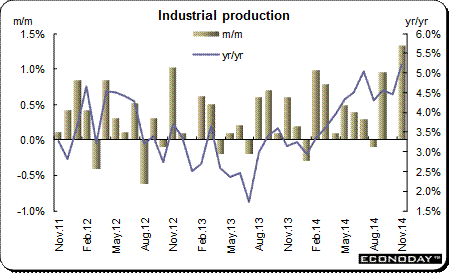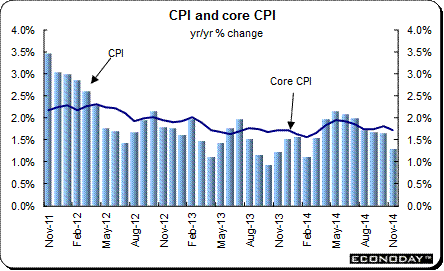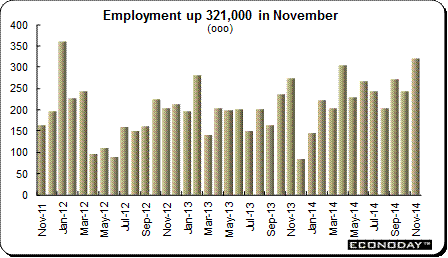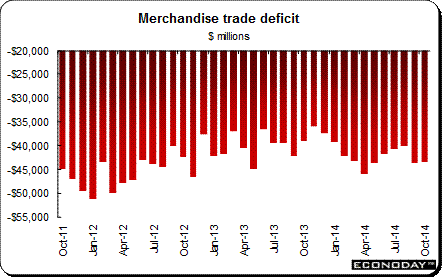
|
Gross Domestic Product and Industrial Production — After real GDP averaged 3.25 percent annual growth in the 1990s, the economy fell into a mild recession in the second and third quarters of 2001. This is despite recent Bureau of Economic Analysis revisions that amended the data and now show no decline at that time. The events on September 11, 2001 exacerbated the downturn already in progress. GDP recovered in the first quarter of 2002 and the economy has grown in fits and starts since then. A strong housing market combined with low interest rates fueled consumer spending. The economy soared in the second half of 2003 and into 2004 thanks to tax cuts that gave consumers more money to spend.
But while growth slowed perceptively in the first half of 2008, gross domestic product remained positive until the third quarter. Slow employment growth continues to wound consumer spending today. The credit crunch and ensuing financial market woes spread to the real economy and brought growth to a screeching halt. Although oil prices were down from their highs it was too late to save consumer spending and corporate profits and they both sank. According to GDP, the economy emerged from recession in the third quarter of 2009.
Quarterly growth slowed in the fourth quarter of 2013 with the weather being blamed for the slowdown. GDP was up a revised 0.9 percent on the quarter and up 3.1 percent from the same quarter a year ago. On an annualized basis, GDP was up 3.5 percent. First quarter GDP slowed dramatically, thanks to dreadful winter weather. On the quarter, GDP was revised downward to a contraction of 0.5 percent and was up 1.9 percent from the same quarter a year ago. On an annualized basis GDP contracted 2.1 percent. The economy rebounded in the second quarter of 2014. GDP was up 1.1 percent on the quarter and up 2.6 percent from the same quarter a year ago. On an annualized basis, GDP was up 4.6 percent.
The second estimate of third quarter GDP was revised to 1.0 percent from the initial estimate of 0.9 percent on the quarter. On the year, GDP was up an unrevised 2.4 percent when compared with the third quarter in 2013. The economy grew at an annualized pace of 3.9 percent.
Industrial production had its ups and downs in 2012 thanks in part to acts of nature. Hurricane Isaac hit the Gulf coast during the summer and in October output was hurt by superstorm Sandy that hit the U.S. East Coast. Industrial production declined in two of 12 months in 2013 — April and July. Meanwhile, manufacturing output was down three of 12 months in 2013 — January, April and July.
Thus far in 2014, monthly industrial output declined in January and August and advancing in the remaining months. Manufacturing also was down in January and August. However, monthly increases in the other nine months, wiped out the losses and then some.
In November, industrial output was up 1.1 percent on the month and 5.1 percent from a year ago. At the same time, manufacturing added 1.3 percent and was up 5.2 percent on the year.
Inflation — Inflation continues to be under control and run below the Federal Reserve's 2 percent target. In 2013, the CPI was up 1.5 percent and core was up 1.7 percent. In January 2014, inflation remained tame. On the month, both the CPI and the core excluding food and energy were up 0.1 percent. On the year, both indexes remained below the Federal Reserve's inflation target of 2.0 percent and were up 1.6 percent. In February, once again the indexes edged up 0.1 percent on the month. The overall CPI was up 1.1 percent while core increased 1.6 percent on the year.
Since March, both the overall CPI and core were up each month through July. In August however, the overall CPI edged down 0.2 percent on the month while the core was virtually unchanged. From a year ago, both the overall CPI and core were up 1.7 percent. In September, the CPI edged up 0.1 percent on the month and 1.7 percent on the year. Core CPI also was up 0.1 percent and 1.7 percent. In October, the CPI was unchanged on the month and up 1.7 percent from a year ago. Core was up 0.2 percent and 1.8 percent. In November, the overall CPI retreated with a monthly decline of 0.3 percent and was up 1.3 percent from a year ago. Core edged up 0.1 percent and 1.7 percent. Gasoline prices continued to decline, dragging the overall index downward.
Unemployment — The civilian unemployment rate bottomed out at 3.9 percent in September 2000, a rate that had not been seen since January 1970. But with the onset of recession, unemployment climbed especially in the manufacturing sector. Increases in unemployment were mitigated by the mild nature of the recession. Unemployment is typically a lagging indicator and generally increases even after a recovery is in place. Unemployment was on a downward trajectory until July 2006, when it climbed to 4.8 percent after two months at 4.6 percent. The unemployment rate ranged narrowly between 4.4 percent and 4.8 percent in 2007 until December 2007 when it jumped to 5 percent.
The unemployment rate climbed rapidly to 10.0 percent in November and December 2009 but eased to 9.7 percent in January 2010 where it was for three months before it resumed its downward track. Since the beginning of 2012, the unemployment rate has continued to trend downward but with occasional bumps upward. The unemployment rate was 6.3 percent in May 2014 for a second month. In June the unemployment rate slipped to 6.1 percent but edged up to 6.2 percent in July. The July increase was attributed to a higher participation rate. Unemployment declined to 6.1 percent in August. In September it dropped below the 6 percent level to 5.9 percent and the lowest since July 2008. It continued to decline in October — this time to 5.8 percent. It remained at 5.8 percent in November.
Employment plummeted for 22 consecutive months reaching a crescendo in January 2009 when 818,000 jobs were lost in that month alone. The employment declines remained massive even as they steadily declined in size. Employment finally bumped up in March, April and May of 2010. The improvement in employment continues to be slow with the number of new jobs fluctuating from month to month rather than showing the steady and rising increases that were typical of previous recoveries. Employment has increased in every month since October 2010. In 2012, the economy added 2,193,000 jobs. The U.S. added 2,331,000 in 2013.
An average of over 200,000 jobs per month has been added so far in 2014. Employment added 271,000 jobs in September and 243,000 in October. So far in 2014 the economy has added 2,650,000 jobs.
Merchandise trade — The United States reliance on foreign goods intensified in the 1990s, although export growth improved modestly during the period too. In good economic times, imports help alleviate demand pressures and therefore help curtail price inflation for goods and services. In downturns, a decline in demand for goods also leads to a drop in import demands so that foreign producers feel the effect of a U.S. downturn and the negative impact on domestic producers is mitigated to some extent. Investors overseas have mixed feelings about the U.S. trade deficit. On one hand it means that U.S. consumers continue to buy their exports, which in turn stimulates their domestic economies. Even though the deficit began to narrow in 2012 as U.S. exports continued to increase, the path has not been smooth and there is still a long way to go. The deficit expanded to $46.0 billion in April, but declined to $43.4 billion in May and $40.8 billion in June. In August, the deficit edged down to $40.1 billion. However, in September, the deficit climbed to $43.6 billion. In October, the deficit was little changed at $43.4 billion.
|
|||||||
| Legal Notices | ©Copyright 1998-2024 Econoday, Inc. |
powered by
![[Econoday]](images/logo.gif)
![[Apple App Store]](/images/AppleAppStore.png) ![[Econoday on Kindle]](/images/kindle.jpg) 
|
||||||





